Niobrara wells prove BHA for coiled tubing
Gyro-steered tool drills S-curve, directional and horizontal wells in shallow reservoir using mud in build section, air in horizontal section
By Paul McCutchion, AnTech
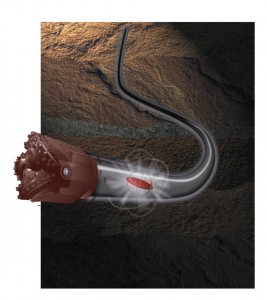
A recent five-well drilling program in the Niobrara formation along the Colorado-Kansas border has demonstrated a new bottomhole assembly (BHA) for coiled-tubing drilling (CTD) that is suitable for drilling directional, S-curve and horizontal wells in shallow reservoirs. Using gyro-while-drilling technology, it enables pad drilling with the associated reduction in environmental footprint.
Mud was used for the build section of each well, and air was used for the horizontal sections. Valuable lessons were learned that will increase the efficiency of future programs.
Introduction
For operators seeking to develop a shallow reservoir with a directional or horizontal wellbore, BHA options can be limited. A feature of this type of well is the limited depth that is available to build angle between the surface casing shoe and the target reservoir. If the build-up rate is too high, it may make it difficult to run casing; if the build-up rate is too low, it may mean the borehole misses the target position.
To counter this problem, the directional driller has to make maximum use of the depth available. This may mean, for example, kicking off directly from the surface casing shoe while the measurement-while-drilling (MWD) sensor is still in the casing.
Until now, the options available for this work have been steerable motors on jointed pipe or rotary steerables, both with mud-pulse MWD and usually with magnetic steering tools. In both cases, magnetic interference from the steel casing means that a straight hole must be drilled from the casing shoe until the MWD sensor is 20 ft to 40 ft out of the shoe before kick-off orientation can be made. This wastes valuable vertical depth to drill the curve. Drilling with jointed pipe requires an extra gyro run to overcome this situation, and the build rates required for these applications could be difficult for rotary steerable technology to achieve.
AnTech’s new gyro-steered POLARIS BHA is a CTD-based solution, capable of drilling hole sizes up to 8 ½ in. and drilling underbalanced to avoid overpressurizing the reservoir. Further, it can orient while remaining in the casing.
The wireline tool is used in combination with a motor that features a bent sub to control the direction of the bit. The bit can be pointed in any direction due to a rotating orienter that rotates the entire tool assembly. Rotating the tool continuously would drill a straight hole.
Positional data is collected through the system’s gyro system, which uses a solid state gyro to determine the 3D position of the tool. Further, the gyro system allows the tool to be short, as space can be reduced versus what’s required for magnetic steering tools; also, non-magnetic materials are not required.
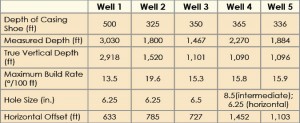
Drilling program
The new BHA was tested in a five-well program in the Niobrara, completed in two phases between November 2011 and February 2012. One S-curve well and two deviated wells – one more deviated than the other – were selected to be drilled overbalanced with mud. Two horizontal wells were selected to be drilled with air.
All wells had their surface hole drilled and casing set using a water-well rig. No pad or access road was prepared in accordance with the low-margin nature of the wells in the particular field.

Five wells drilled
Well 1 (S-Curve)
This well trajectory was planned so the rig could be placed next to a cornfield that was being harvested to prevent causing the landowner the inconvenience of drilling a vertical well in the middle of his crop.
Wells 2 & 3 (Deviated)
The reservoir target for these wells was situated where the terrain – dry river beds, in this case – made it difficult to site a rig for a vertical well. The deviated wellbore, therefore, prevented a compromise being made in terms of reservoir exploitation.
Wells 4 & 5 (Horizontal)
Both of these wells were planned with an intermediate section, which was drilled with mud using an 8 1/2-in. bit. The horizontal section was air-drilled with a 6 1/4-in. bit. Air was used for these wells because the formation was able to hold the pressure of a liquid column.
The POLARIS tool produces real-time readings of downhole vibration. When air drilling, or more accurately with the bit off bottom, shock spikes of up to 250g were recorded by the accelerometers. This data will be analyzed with a view to modifying operational procedures and future tool qualification tests.
Key statistics of the wells drilled are shown in Table 1.
Operational benefits
The program demonstrated that the POLARIS can drill directional and horizontal wells with hole sizes ranging from 6 1/4 in. to 8 1/2 in. and with both mud and air as the drilling fluid. In addition, it highlighted the following operational benefits, which enable operators to drill shallow wells economically with minimum impact on the environment:
• Accurate paths were drilled, hitting the pay zone and following well plans;
• The operator was able to kick off as soon as the bit exited the casing, but with the gyro MWD tool still within it. This kept the build rates to the minimum necessary to achieve the target, making casing running easier. This is essential for many shallow well operations;
• Multiple wells can be drilled from the same pad by using the gyro system to control the direction of the tool; and
• The tool effectively survived and functioned in the air-drilling environment, which can be difficult for downhole tools.
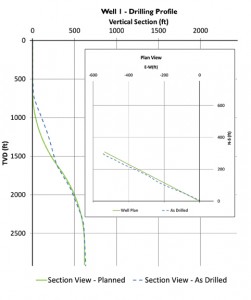
The success of the program demonstrates that low-margin wells can be drilled in locations and at times that may not be currently considered feasible.
Lessons learned
Several lessons were noted during the tool’s first field application, including:
• When kicking off, allowances must be made for the twist of the coil, which is significant. This can be measured by the tool;
• When drilling shallow wells, there is little or no time to correct if the wellbore trajectory deviates from the plan. This highlights the importance of precise planning, accurate tools and good training;
• The tool’s ability to respond depends on the build rate that can be achieved for a particular motor bend setting in the specific rock formations being drilled. The drilling program must allow time to establish this response so that motor bend settings are correctly chosen; and
• The size of casing must be selected in accordance with the size and bend angle of the motor, or problems may arise during tool makeup at surface and during orientation in the casing prior to kick-off.
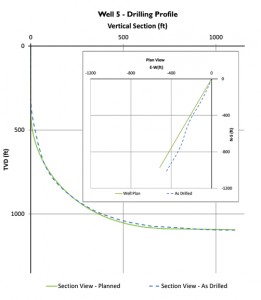
Drilling tool and adaptable hybrid drilling rig
The success of this campaign can be attributed to the combined use and performance of the new tool and a hybrid drilling rig that can run coiled tubing and jointed pipe, as well as run and pull casing. This adaptability means that operations can be performed quickly and efficiently with one rig.
Previous studies have shown that CTD can reduce drilling times between 30% and 60%, compared with standard jointed pipe drilling rigs.
Two of the primary aims of this program were to prove the accuracy and reliability of the new gyro system.
“From the first directional well to drilling horizontally with air, the gyro system provided accurate readings and withstood the harsh drilling vibrations,” Toni Miszewski, managing director of AnTech, said. He added that the short length of the tool means the sensors are close to the bit and corrective actions can be carried out immediately. This allows the tool to drill directionally with precision and cost efficiency.
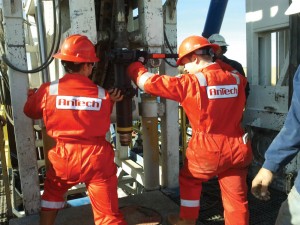
Where directional CTD should be used
CTD stands out for its speed and ability to drill within the reservoir in an underbalanced condition. Extending directional capability to larger hole sizes opens up new opportunities to economically exploit fields more efficiently. Each application must be evaluated on the benefits that it might bring. Generally, CTD works in situations where the geology and drilling conditions are well known and are not complex.
Like many specialized services that are tuned to efficiency, CTD provides speed at the expense of the general-purpose adaptability of a jointed pipe rig and rotary drilling. That said, modern hybrid rigs are also capable of rotary drilling to provide a backup option should conditions require it.
The first three wells of this directional CTD project took advantage of its ability to pinpoint a particular spot in the reservoir without having to physically position the rig vertically above it. However, the reasons for using  directional CTD for the last two wells were more complex. The primary objective was to open up more of the reservoir to the wellbore and keep the formation fractures clean by drilling horizontally and underbalanced. In any case, the well needed to be drilled underbalanced because of the propensity of the formation to take fluid.
directional CTD for the last two wells were more complex. The primary objective was to open up more of the reservoir to the wellbore and keep the formation fractures clean by drilling horizontally and underbalanced. In any case, the well needed to be drilled underbalanced because of the propensity of the formation to take fluid.
Additional reasons to consider directional CTD that were not part of the drilling program completed are:
• The ability to drill multilateral branches from the main wellbore;
• The ability to drill multiple wells from a single pad using the gyro capability to avoid well collisions; and
• Drilling in, or close to, built-up areas where the smaller environmental footprint makes drilling a less intrusive activity.
In some cases, the combination of CTD, horizontal wellbores and underbalanced drilling will obviate the need for further treatments, such as acidizing and hydraulic fracturing, which may make projects economically viable when they might not have been otherwise.
The success of these operations has shown that the POLARIS tool could allow CTD technology to address applications such as unlocking reserves in mature oilfields (re-entry drilling) and for directional drilling in coalbed methane projects.
POLARIS is a trademark of AnTech.




